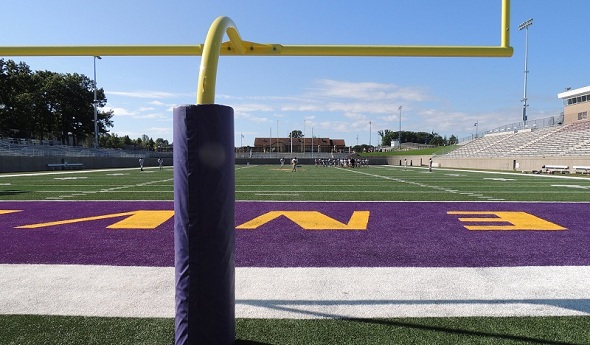
A Legacy Begins in Greenville
August 24, 2012
By Geoff Kimmerly
Second Half editor
GREENVILLE – Curtis Heppe has no idea what to expect, but a few guesses and a dream or two of how it will feel tonight to lead his teammates into Greenville's Legacy Field for the first time.
“It’s going to be electric, for sure. It’s a new vibe. It’s high-tech there,” the Yellow Jackets quarterback said Thursday after his team’s final preseason practice.
Those expectations are shared by a community that will be cheering on the local team in a new home after nearly a century at the legendary Black Field.
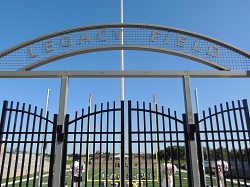 Workers put the finishing touches on the near-$7 million facility this week in advance of the season's first varsity game, tonight against rival Belding. Legacy Field officially opened for Wednesday’s freshman game, and Heppe said that even for that lower-level appetizer, the stadium began to come alive.
Workers put the finishing touches on the near-$7 million facility this week in advance of the season's first varsity game, tonight against rival Belding. Legacy Field officially opened for Wednesday’s freshman game, and Heppe said that even for that lower-level appetizer, the stadium began to come alive.
“We’ve just wanted Friday night to come. To get in and see how intense, how nice this place is,” he said. “Coming out of that tunnel, seeing our fans, it’s going to be the best feeling.”
Tonight’s grand opening will be the culmination of efforts from not just administrators, but students and community members as well – down to the name of the stadium itself.
“Legacy Field” was selected by Greenville’s school board. But it came as a suggestion from the school’s student council, which took submissions from classmates and then with faculty and administrators whittled the list to three favorites – Stinger Stadium and Community Field were next on their list.
But that’s just one way Legacy Field is a blend of old and new and ideas from all over town.
“In development, (it’s been) probably 10 years. We’ve been talking about it ever since I’ve been here, that one day we’d be able to do this,” said Greenville athletic director Brian Zdanowski, who is entering his 15th school year at that post. “It came through strategic planning. It came through community input. And then ultimately, our board bought in that there was enough interest in the community.”
Deeply rooted
A walk through Legacy Field is a history lesson. But first, an explanation of the Yellow Jackets’ past.
Black Field had served as the team’s home since 1916. It is nestled downtown next to Greenville’s former high school, which is now a library.
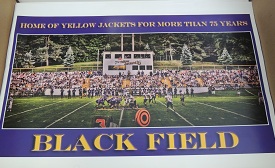 The current high school, about 1.5 miles northwest, was built in 1963. Football teams continued to make the short trip for home games.
The current high school, about 1.5 miles northwest, was built in 1963. Football teams continued to make the short trip for home games.
Black Field has its charms. With no track surrounding the field like at many multi-purpose stadiums, fans are only a few yards from the sideline. And all of that history added to the mystique for the latest players to wear the uniform.
The field also has had peculiarities. Zdanowski said at one point, the end zones were elevated in the corners. And the field wasn’t always square – a 10-yard penalty might measure 11 on one side of the field but only nine yards on the other.
But after just about every home game, students met for a bonfire on the grounds, an extension of the celebration by neighborhoods that surround Black Field and embraced the team for decades.
“It was the typical focal point of the community,” Zdanowski said.
Some things old, many new
Playing on Black Field was special, Heppe added. But he's equally if not more excited to be part of this new legacy. And architects made sure to bring that community feel to the new home this fall.
Destruction and construction began May 2, the day after last season’s final girls tennis match. The courts formerly sat in what is near the south end zone, and were moved closer to the track and soccer facility.
Amenities at the Yellow Jackets’ new football home are comparable to a college stadium’s, starting at the north side of the field.
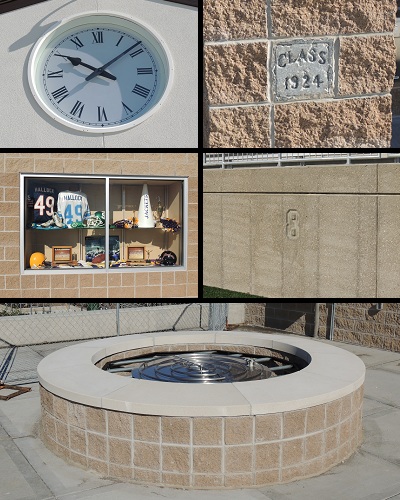 Players will enterthrough a tunnel that pours into the field like that of a miniature Spartan Stadium. Surrounding the tunnel are expansive locker rooms both for the home team and visitors, a similarly expansive training room and officials area and plenty of storage that will allow Greenville’s entire football program to be housed under that one roof. Unlike Black Field, tucked neatly among its neighbors, Legacy Field has plenty of parking and lighting, and builders were able to make that possible while also keeping intact a group of large oak trees near the south gate.
Players will enterthrough a tunnel that pours into the field like that of a miniature Spartan Stadium. Surrounding the tunnel are expansive locker rooms both for the home team and visitors, a similarly expansive training room and officials area and plenty of storage that will allow Greenville’s entire football program to be housed under that one roof. Unlike Black Field, tucked neatly among its neighbors, Legacy Field has plenty of parking and lighting, and builders were able to make that possible while also keeping intact a group of large oak trees near the south gate.
The turf is synthetic, like that played on by all but one member of the Yellow Jacket’s O-K Bronze conference. The difference from many is that the field has been dug out from the surrounding property, making it even more a focal point for those who will occupy the roughly 4,000 seats in the surrounding cement bowl. (The removed dirt was used to build two Little League fields on another part of the property.)
The sound system is of course state-of-the-art, and the press box, concessions area and restrooms also are equally expansive. But what locals should notice most are the throwbacks to the past that dot every corner of their new home.
Cut into the brick work near the concession counter is a block from Black Field that had been dedicated by the school’s class of 1924. Atop the building is the Centennial Clock, 100 years old this year, which formerly hung at the entrance the old school and was donated by the class of 1912. It has been housed by Greenville’s museum until being re-donated to the school district to become part of the stadium.
Molded into the cement walls on the west and south sides of the field are the numbers formerly worn by players Henry Loding and Greg Blumberg. Both died from football-related injuries; Loding in 1906 and Blumberg in 1977. Two trophy cases are cut into the stone on the facing of the press box, including one featuring mementos celebrating alum and former Detroit Lions tight end Ty Hallock.
Another addition of historical significance will come later. The school’s first Hall of Fame class will be inducted before the Sept. 7 game, and that display will be housed near the south ticket area so residents and fans can check it out without having the enter the stadium itself.
And one last thing was added to keep with tradition. To the west of the concession area, but within the stadium fence, sits a large gas fire pit for those postgame gatherings – plus a sound system where students can plug in their mp3 players.
“We said we’re not forgetting our past, but we’re embracing our future,” Zdanowski said. “I’m sure a lot of people have said that before. So we really wanted to make sure we got community input on it and do as much as we could to replicate Black Field. … And I think we won some people over. We really wanted to do what we said (we’d do).”
PHOTOS: (Top) Greenville's junior varsity ran through drills during a morning session at Legacy Stadium, which opened this week. (Top middle) The ticket area and gate for fans sit on the south side of the field. (Middle) A poster given out last season celebrated the final to be played at Black Field. (Bottom middle) A number of pieces of Black Field's past and Greenville tradition were brought over to or included in Legacy Field, including Centennial Clock, which formerly was part of the old school.
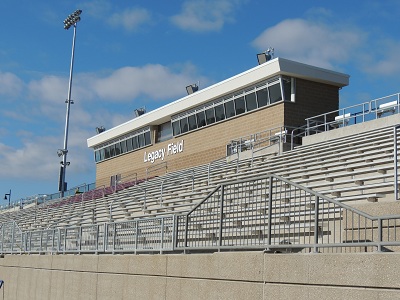
Legacy Field's press box is split into areas for game workers, coaches and media with a roll-up door for film crews.
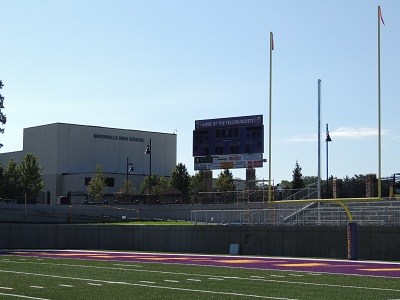
Legacy Field sits between Greenville's high school and middle school and adjacent to its soccer and track facilities.
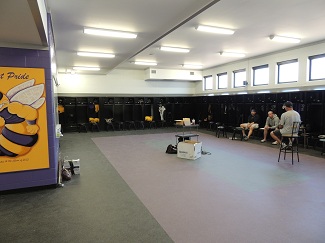
Coaches met in the spacious varsity locker room Monday morning. Junior varsity and freshman locker rooms are connected by a hallway with access to storage areas and the coaches' office.
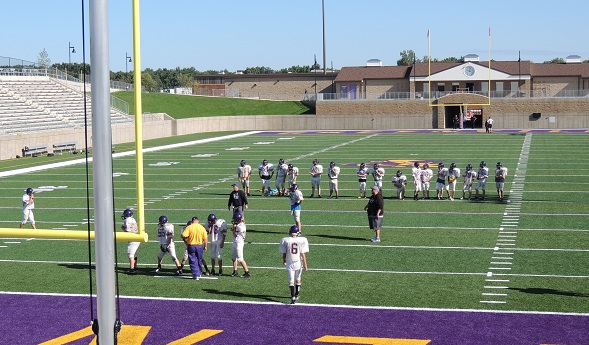 Players will enter Legacy Field through a tunnel at its north end. Above sits the concession area and restrooms, and the Centennial Clock that once ticked in the old Greenville school.
Players will enter Legacy Field through a tunnel at its north end. Above sits the concession area and restrooms, and the Centennial Clock that once ticked in the old Greenville school.
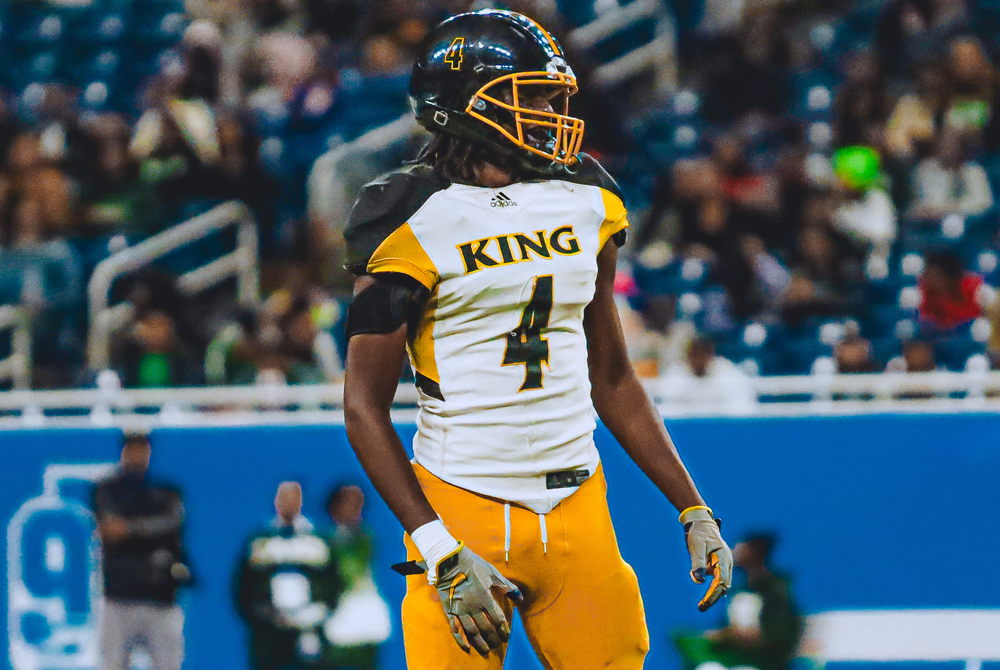
King Eager to Begin Next Championship Pursuit Following Familiar Leader Patrick
By
Keith Dunlap
Special for MHSAA.com
August 22, 2024
DETROIT — To many around the state, it was a collective gasp and curiosity as to how the Detroit Martin Luther King football program would move forward.
 To those within the King program itself, it was a collective shoulder shrug and “we’ll be fine.”
To those within the King program itself, it was a collective shoulder shrug and “we’ll be fine.”
Days after a 26-20 loss to Mason in a Division 3 Semifinal last fall, King saw longtime head coach Tyrone Spencer leave to take the same job at East Kentwood.
It was no small loss, given Spencer had guided the Crusaders to one Division 2 and three Division 3 championships over eight seasons.
Not long after, longtime assistant Terel Patrick was named the new head coach for King. But even he was still processing what happened.
“A little bit of shock,” Patrick said of his initial reaction. “Every year, there were people trying to gauge whether he would or not leave. It wasn’t new that people were interested in him because he did that good of a job. But he always said no. With him saying yes, it kind of shocked me a little bit.”
But after the initial shock, it became business as usual for one of the top programs in the state.
Spencer certainly didn’t leave the cupboard bare in terms of the elite blue-chip talent the program usually enjoys, and there was about as much continuity in a coaching transition as one could hope.
All of King’s assistants stayed with the program, and Patrick said 14 are graduates of the school. Patrick has been on King’s staff since 2009 and called the continuity within the coaching staff a “unique situation.”
 “Spence was always in charge of the defense, and I was always in charge of the offense,” Patrick said. “The biggest thing for me was that I had to relearn a different side of the football.”
“Spence was always in charge of the defense, and I was always in charge of the offense,” Patrick said. “The biggest thing for me was that I had to relearn a different side of the football.”
To do that, Patrick spent the offseason at clinics and in phone conversations with defensive experts he knows. “Just to pick their brains and see what they think in certain situations,” he said.
Patrick shouldn’t be too concerned about picking up any new defensive acumen, given it helps to have supreme talent as always.
Senior defensive ends Xavier Newsom and Willie Fletcher, Jr., are highly-rated college prospects and considered among the best players in the state. Newsom said because the coaching staff remained mostly intact after Spencer left, there was no need to reassure the rest of the team and others that everything would be OK.
“We didn’t have to do that,” he said. “We still had Coach TP, so it’s not like we got a whole new coach. We told everybody that the program is still going to be the same. Nothing is going to fall off.”
King also should be loaded on offense, with sophomore quarterback Darryl Flemister coming off a terrific freshman year as the starter. He is already on the radar of prominent college programs.
Junior running back Michael Dukes rushed for 925 yards last year as a sophomore, while shifty senior slotback David Calmese is also back.
“The biggest thing is keeping the main goal the main goal,” Calmese said.
The coaching change certainly wasn’t enough to change the expectations of others within the Detroit Public School League. The Crusaders were picked to win the Blue division ahead of rival and fellow state power Detroit Cass Tech.
In addition to still being talented, King will be plenty motivated after not making it down the street to Ford Field last year thanks to the Semifinal loss to Mason.
“We’re not used to losing,” Newsom said. “Seeing us fall short, it definitely made us hungry.”
 Keith Dunlap has served in Detroit-area sports media for more than two decades, including as a sportswriter at the Oakland Press from 2001-16 primarily covering high school sports but also college and professional teams. His bylines also have appeared in USA Today, the Washington Post, the Detroit Free Press, the Houston Chronicle and the Boston Globe. He served as the administrator for the Oakland Activities Association’s website from 2017-2020. Contact him at [email protected] with story ideas for Oakland, Macomb and Wayne counties.
Keith Dunlap has served in Detroit-area sports media for more than two decades, including as a sportswriter at the Oakland Press from 2001-16 primarily covering high school sports but also college and professional teams. His bylines also have appeared in USA Today, the Washington Post, the Detroit Free Press, the Houston Chronicle and the Boston Globe. He served as the administrator for the Oakland Activities Association’s website from 2017-2020. Contact him at [email protected] with story ideas for Oakland, Macomb and Wayne counties.
PHOTOS (Top) Detroit Martin Luther King’s Xavier Newsom awaits the next play during last season’s Detroit Public School League Blue championship game at Ford Field. (Middle) First-year Crusaders head coach Terel Patrick speaks during PSL media day Aug. 1. (Top photo by Olivia B. Photography; middle photo by Keith Dunlap.)

